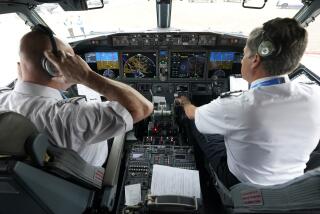FAA Proposes New Rules to Upgrade In-Flight Emergency Medical Care
- Share via
In the early days of commercial aviation, flight attendants often were registered nurses too. Then came World War II, and nurses were needed elsewhere.
Even so, flight attendants are still called on to remedy medical problems aloft. And they may soon receive more intense medical and first-aid training, if a proposed Federal Aviation Administration regulation goes into effect.
The proposal, announced in late May, would require most commercial U.S. air carriers--those with at least one flight attendant per plane--to carry an automatic external defibrillator (AED), a laptop-size, battery-operated device. The AED delivers an electrical shock to restore a heart’s normal rhythm after cardiac arrest.
The proposal also requires airlines to add new items to their on-board medical kits.
Eight major U.S. carriers and six regional carriers either have AEDs on board or plan to, according to the FAA. And carriers that are voluntarily stocking AEDs also tend to stock expanded medical kits, according to a representative of the Assn. of Flight Attendants, which represents 47,000 flight attendants at 26 U.S. carriers.
The FAA was directed to study the issue of on-board medical equipment under the Aviation Medical Assistance Act of 1998.
The proposal followed an analysis of cardiac-related problems aloft on 15 airlines from July 1, 1998, through June 30, 1999. During the study period, five of the 15 carriers had begun to voluntarily stock the AEDs. At the same time, 119 cardiac-related events were reported, resulting in 64 deaths. The AEDs were used in 17 events and prolonged the life of four passengers. In 40 of the 119 cardiac-related events, no AED was on board.
About 350,000 Americans are struck by cardiac arrest each year, the FAA estimates. If an AED is readily available, the chances of survival are high if the device is used in the critical first three or four minutes after cardiac arrest.
Besides requiring AEDs, the FAA proposal would add to on-board medical kits. They now contain a sphygmomanometer to measure blood pressure, a stethoscope, breathing tubes, syringes, needles, dextrose injection to treat low blood sugar or insulin shock, epinephrine to treat asthma or allergic reactions, diphenhydramine for allergic reactions, nitroglycerin tablets for cardiac-related pain, latex gloves and instructions for use of the medications.
Under the new proposal, the airlines would add oral antihistamine, nonnarcotic pain reliever, aspirin, atropine (for dilating pupils and other uses), bronchodilator inhaler, lidocaine and saline, an IV administration kit, CPR masks and a bag to help breathing after use of the AED.
The proposed regulations also require training flight attendants in use of the new materials.
The Assn. of Flight Attendants wants the training to be standardized, conducted by the Red Cross and regulated by the government, not by the airlines.
Currently, medical training of flight attendants varies from carrier to carrier, AFA president Patricia A. Friend told a House subcommittee last month. Some carriers give flight attendants less than 30 minutes’ instruction in basic first aid, she said; others provide several hours of training.
The AFA also wants carriers to give flight attendants letters of indemnification, protecting them from passenger claims related to attendants’ use of AEDs.
The FAA is accepting public comments on the proposed regulation until Sept. 21. Processing the comments will take several months, an FAA representative said.
On the Internet, visit https://dms.dot.gov to submit an e-mail comment. Or send written comments in duplicate to Department of Transportation, Dockets, Docket #FAA-2000-7119, 400 7th St. S.W., Room 401, Washington, DC 20590.
Healthy Traveler appears the second and fourth Sundays of the month. Kathleen Doheny can be reached at kdoheny@compuserve.com.
More to Read
Inside the business of entertainment
The Wide Shot brings you news, analysis and insights on everything from streaming wars to production — and what it all means for the future.
You may occasionally receive promotional content from the Los Angeles Times.










